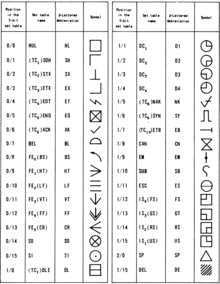


ISO 2047 (Information processing – Graphical representations for the control characters of the 7-bit coded character set) is a standard for graphical representation of the control characters for debugging purposes, such as may be found in the character generator of a computer terminal; it also establishes a two-letter abbreviation of each control character.[1] The graphics and two-letter codes are essentially unchanged from the 1968 European standard ECMA-17[2] and the 1973 American standard ANSI X3.32-1973.[3] It became an ISO standard in 1975.[1] It is also standardized as GB/T 3911-1983 in China, as KS X 1010[4] in Korea (formerly KS C 5713), and was enacted in Japan as "graphical representation of information exchange capabilities for character" JIS X 0209:1976 (former JIS C 6227) (abolished January 20, 2010).
While the ISO/IEC 646 three-letter abbreviations (such as "ESC"), or caret notation (such as "^[") are still in use, the graphical symbols of ISO 2047 are considered outdated and rare.[5]
| Code (hex) |
Common abbreviation |
Name | Symbol[1][2][6][7][8] | 2-letter abbreviation | |
|---|---|---|---|---|---|
| 00 | NUL | Null | ⎕ | U+2395 | NU |
| 01 | TC1, SOH | Start of Heading | ⌈ | U+2308 | SH |
| 02 | TC2, STX | Start of Text | ⊥ | U+22A5 | SX |
| 03 | TC3, ETX | End of Text | ⌋ | U+230B | EX |
| 04 | TC4, EOT | End of Transmission | ⌁ | U+2301[9] | ET |
| 05 | TC5, ENQ | Enquiry | ⊠[a] | U+22A0 | EQ |
| 06 | TC6, ACK | Acknowledge | ✓ | U+2713 | AK |
| 07 | BEL | Bell | ⍾ | U+237E[9] | BL |
| 08 | FE0, BS | Backspace | ⤺ | —[b] | BS |
| 09 | FE1, HT | Horizontal Tabulation | ⪫ | U+2AAB | HT |
| 0A | FE2, LF | Line Feed | ≡ | U+2261 | LF |
| 0B | FE3, VT | Vertical Tabulation | ⩛ | U+2A5B | VT |
| 0C | FE4, FF | Form Feed | ↡ | U+21A1 | FF |
| 0D | FE5, CR | Carriage Return | ⪪ | U+2AAA | CR |
| 0E | SO | Shift Out | ⊗ | U+2297 | SO |
| 0F | SI | Shift In | ⊙ | U+2299 | SI |
| 10 | TC7, DLE | Data Link Escape | ⊟ | U+229F | DL |
| 11 | DC1, XON, CON[10] | Device Control 1 | ◷ | U+25F7 | D1 |
| 12 | DC2, RPT,[10] TAPE[c] | Device Control 2 | ◶ | U+25F6 | D2 |
| 13 | DC3, XOF, XOFF | Device Control 3 | ◵ | U+25F5 | D3 |
| 14 | DC4, COF, KMC,[10] |
Device Control 4 | ◴ | U+25F4 | D4 |
| 15 | TC8, NAK | Negative Acknowledge | ⍻ | U+237B[9] | NK |
| 16 | TC9, SYN | Synchronization | ⎍ | U+238D | SY |
| 17 | TC10, ETB | End of Transmission Block | ⊣ | U+22A3 | EB |
| 18 | CAN | Cancel | ⧖ | U+29D6 | CN |
| 19 | EM | End of Medium | ⍿ | U+237F[9] | EM |
| 1A | SUB | Substitute Character | ␦ | U+2426[12] | SB |
| 1B | ESC | Escape | ⊖ | U+2296 | EC |
| 1C | IS4, FS | File Separator | ◰ | U+25F0 | FS |
| 1D | IS3, GS | Group Separator | ◱ | U+25F1 | GS |
| 1E | IS2, RS | Record Separator | ◲ | U+25F2 | RS |
| 1F | IS1US | Unit Separator | ◳ | U+25F3 | US |
| 20 | SP | Space | △ | U+25B3 | SP |
| 7F | DEL | Delete | ▨ | —[d] | DT |